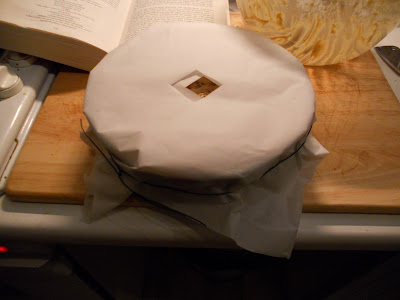First things first, we make the curry. You'll need, for two people:
Two lamb steaks, chopped into roughly 1 1/2 inch dice
2 tablespoons cooking oil
2 onions diced very finely
2 teaspoons root ginger, grated
2 - 3 cloves garlic, crushed
2 teaspoons ground coriander
2 teaspoons ground cumin
1 teaspoon paprika
1 teaspoon garam masala
Chilli powder to taste
3 medium-small potatoes, chopped into chunks of about twice the size of your top thumb knuckle
 First step is to gently fry the onions until they are golden brown and starting to mush up. This is the most vital bit of all - the base of your sauce - and cannot burn. If they look as if they might catch, add a little bit of hot water. This takes quite a while, around 10 minutes or so.
First step is to gently fry the onions until they are golden brown and starting to mush up. This is the most vital bit of all - the base of your sauce - and cannot burn. If they look as if they might catch, add a little bit of hot water. This takes quite a while, around 10 minutes or so.When the onions are virtually melting in the pan, add the garlic and ginger and fry on a low heat for another 5 - 10 minutes. This should smell just gorgeous. Again, add a little bit of water if things might catch. If a little bit does - fish it out of the pan.

Next add all the powered spices into the pan, and fry for another 5 - 10 minutes. The smell coming from this should be redolent of curry now. The spices need to be cooked - important to do this step thoroughly as this is the aromatic heart of your curry. Again, if things look like they might burn, add a little splash of hot water.
Richard, the guy who taught the cookery course and his wife Suzy are a Christian Indian couple from Chennai, hence the original of this recipe including pork. It surprised me - most of the Indian curries I have known and love are veggie, or with lamb, chicken or prawns, so I figured I'd be fairly safe including lamb instead. It worked great.
Take the diced lamb and add to the curry base. Stir fry it (you can turn the heat up a little for this stage) until the meat changes colour, then add the potatoes and enough water to create a liquor but not so much you'll make the sauce watery... this really has to be done by eye, but you'll need enough in there to cook the potatoes. Then simmer until the potatoes are cooked through and the meat is soft. If you put in a little too much, it's okay, especially if you use floury potatoes. As Suzy pointed out, this type soak up more of the water (and the flavour), and as they cook a little longer and fluff up a bit, will thicken the sauce anyway. So all recoverable! This will take a while, so it's time to start the pilau rice. Just before you do though, taste it: this curry appreciates salt and is surprisingly bland without it. I hardly ever use salt during cooking (using pepper, herbs and spices to add flavour) but this needs it.
For the pilau, you'll need (this serves four):
 500g basmati rice, washed three times in a bowl to get rid of the excess starch which makes the rice sticky (although I quite like sticky rice, it's not the texture we're aiming for here)
500g basmati rice, washed three times in a bowl to get rid of the excess starch which makes the rice sticky (although I quite like sticky rice, it's not the texture we're aiming for here)1 onion, diced (this is the one which turned out not to be right, so I had to do without it tonight)
1/2 inch piece of root ginger
4 cloves
3 cardamoms
1 inch of cinnamon stick
2 bay leaves
One of the things that surprised me was the lack of tomatoes in the sauce - it tasted amazing, and is just a different way of cooking curry from the recipes I've used before. This recipe is eminently adaptable, and instead of water to make the sauce, I might use tomatoes next time. I also might finely dice some chillis and fry along with the onion for the curry base, as whilst the curry powder is nice, I slightly prefer the Russian-roulette approach to curry cookery. Hope you give it a whirl, and if you do, let me know how you get along!



























